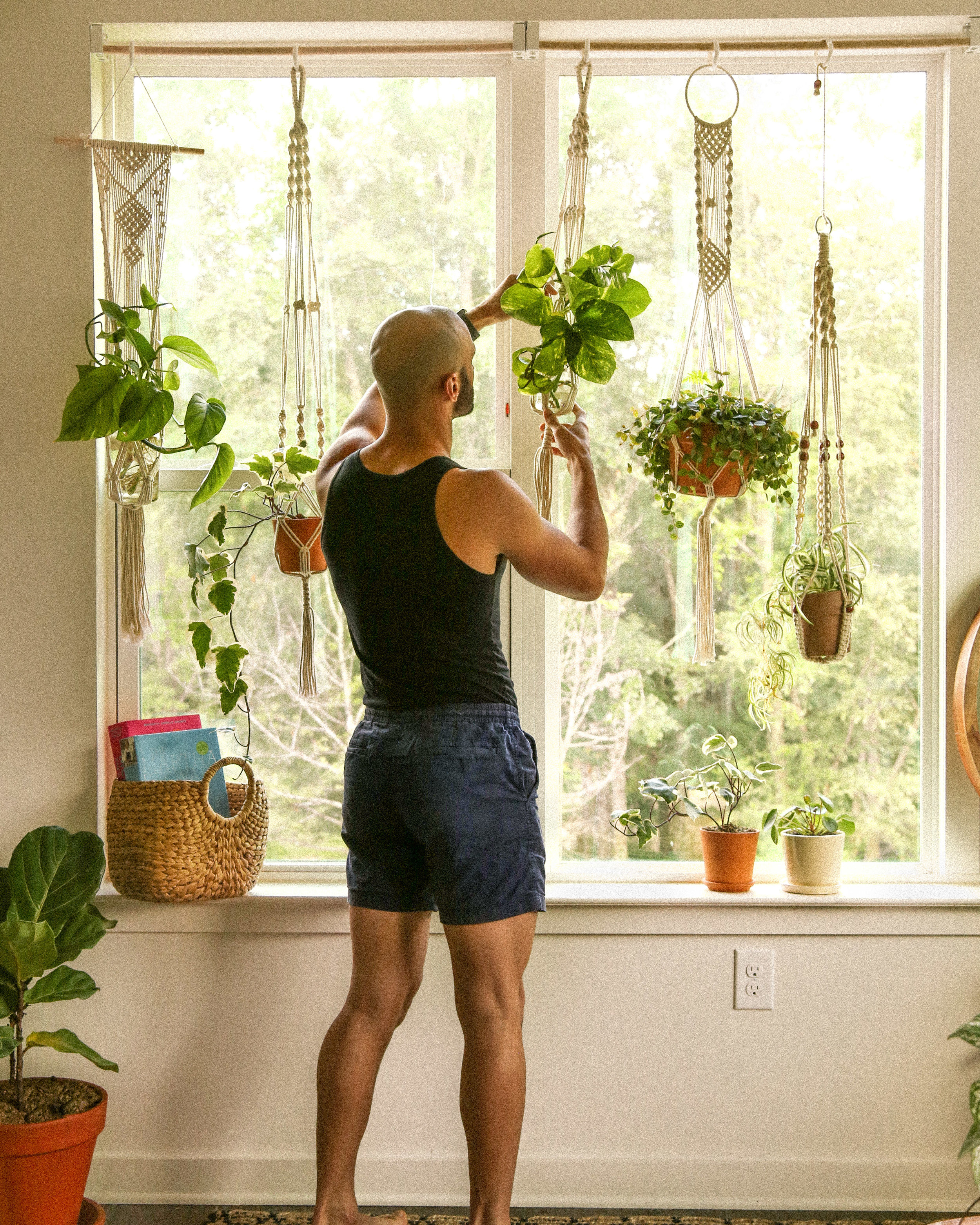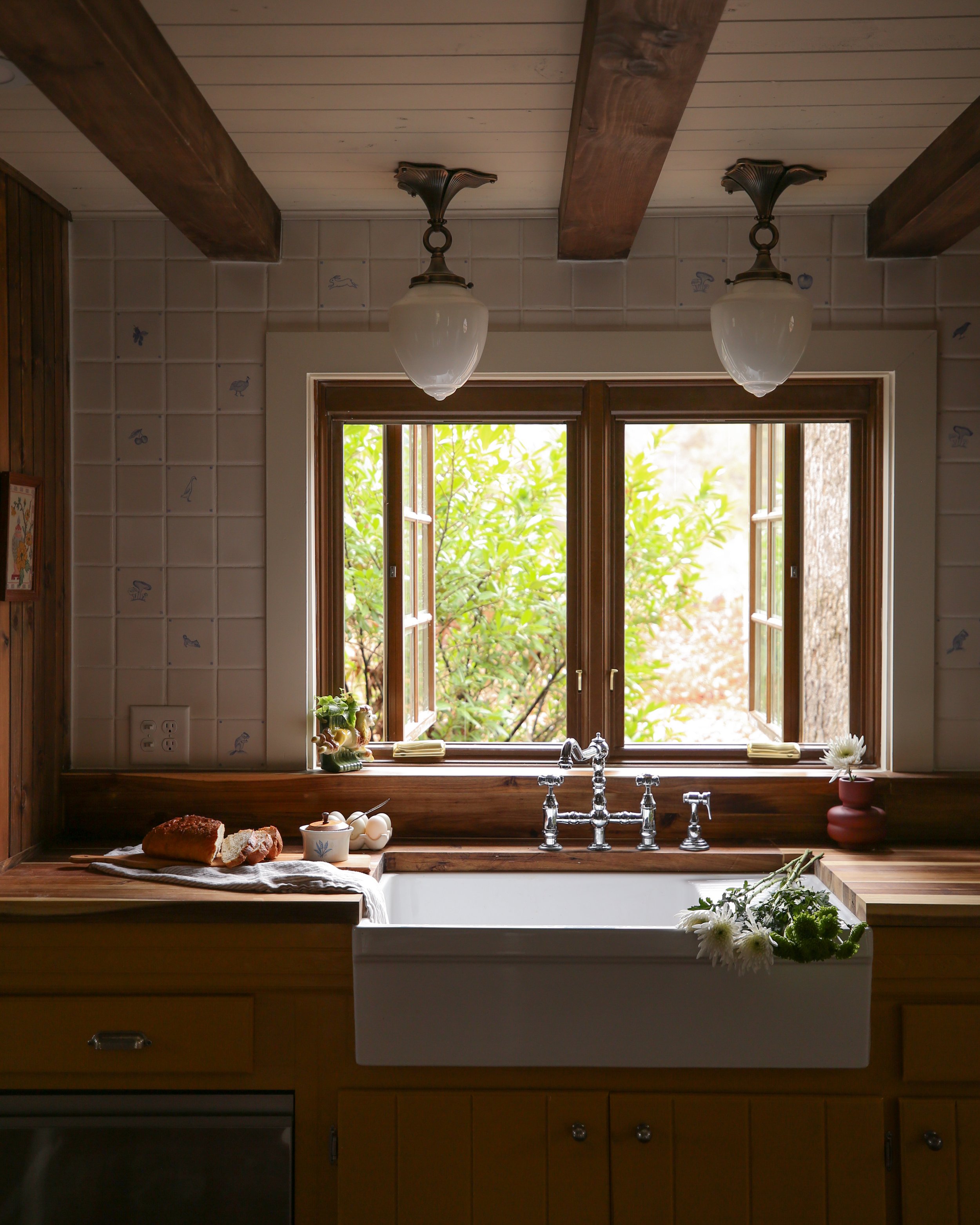DIY Adjustable Plant Window (Renter-Friendly!)
We’re bigggg on plants—especially ones that are easy to care for—because they work so well to give a home, well, life. They’re also believed by many to be great for purifying the air in your home (though the effectiveness is contested). And of course they add a pop of color and can be a nice reminder that you can do something right…if you manage to keep them alive. We love hanging our plants because it takes our plant friends even further in the direction of being living decor. So today we’re talking about a hanging plant set up that is both renter-friendly and easily adjustable. If you’ve got the ability to follow the DIY below (and by that I mean, if you’re house is set up correctly for it), you’ll have a window full of hanging plants that can be easily adjusted, swapped around, and taken down for watering without trouble.
Does this project put you at a higher than average risk for having an entire wall of dead plants staring back at you as you try to unwind every night? Yes. Is that risk easily diminished if you use our #1 recommended house plant for beginners? Probably. Also, while we did this to an entire three-window section of our home, you could keep it to just one window, which is more manageable.
To be completely transparent, we have a weirdly perfect layout for this exact DIY, that you may not have, so really this is more of a “this is what we did, and you can pull from this to fit your space” kinda deal. For starters, two of the walls in our living space are literally just windows. Like, very little wall happening. And it’s a north-facing room which means that almost all of the sun we get is indirect, but extremely bright. There are a lot of very hearty house plants that will basically flourish with very little care in those conditions. We probably would not have done this if there was direct light coming in to this side of the house, because we’d want to have the option of putting the blinds down to block out the light. Finally, the only neighbors we have are trees, so there’s no foot traffic or adjacent home full of people able to see in to our space. If there were, this set-up wouldn’t be the most privacy-friendly arrangement.
What really makes this project good for renters is that, assuming you’ve got blinds installed in your window sill, this requires no drilling or nailing holes or hooks into the ceiling. However, if you don’t have blinds installed in your apartment, you can install the brackets that make this whole project work—though that does mean you’ll have to drill holes.
Below you can find the products we used to make this come together, our method that you can pull from for your own project, and some variations on this that are suitable for a wide-range of apartments.
What You’ll Need:
As mentioned above, this DIY is renter-friendly if you live in an apartment that has previously installed blinds that use mounting brackets. While that’s more or less the standard for many apartment building units, if you want to do this DIY in a space without previously installed blinds, you’ll just need to install the mounting brackets first, which does require drilling holes (which might be fine for you and/or your landlord, but just wanted to give you a heads up).
In our old house, which had wooden ceilings (because #nola), we just used screw in cup hooks with no problem. When used on sheetrocked ceilings, I’ve found these are prone to causing damage and also prone to just falling the fuck out the ceiling, so kinda just be warned if you go that route.
wooden dowels (at least 3/4” thick) adjusted with hacksaw if necessary**
plants**
low-profile window blind mounting brackets (see notes)
Notes
mounting brackets— if you’ve got blinds installed in your home already, you’ll likely have these (see corners of windows in header photo for reference). All you’d need to do in that case is pop open the latch, move the blinds into storage, and carry on with step 2 below. If you don’t have blinds installed and want to do this DIY, you’d need to purchase and install low-profile box window blind mounting brackets according to instructions. The materials here are cheap, but you’ll have to drill in the brackets for installation. These shouldn’t be further than 36” apart, as you’ll otherwise have a hard time finding wooden dowels to fit.
If you don’t have previously installed mounting brackets AND don’t want to install them—as mentioned above, you can use cup hooks to screw directly into your ceiling, though it really will depend on your space. Do your research to make sure these won’t do too much damage, or pop out when you hook on your planter! If you have a curtain rod installed, you can just skip right ahead to step 2 and use the curtain rod to hang your clips and planter hangers from for a similar effect—just make sure the rod can support the weight of the plants.
wooden dowels & adjustment— most wooden dowels we’ve found are 32” or 36". The length is easily adjustable with a cheap (like $10) hack saw you can buy online or at a home improvement store. Just a quick sawing motion will get you where you need to be. What’s also important here is how thick the dowel is, as you want it at least 3/4” thick so that it can support the weight of the planter hangers without bending.
shower curtain rings— the shower curtain rings allow you to clip, unclip, and adjust your plants on the dowel with ease. We had an old package of white plastic shower curtain rings that did the trick perfectly. I hate buying plastic so the fact that we had these already from years ago was nice. You could use aluminum rings, or skip this part and just use the loop at the top of the planter hangers (though that means to remove the hangers for watering, you’ll need to unhook and remove the entire dowel which can be hard if you’ve got like five plants on it).
Step 1
Assess what you need for this DIY based on the list above. If you’ve got window blinds with mounting brackets already installed, pop open the latch and remove blinds, and move on to step 2. If not, you’ll need to install the mounting brackets (see notes above) before continuing on. If you don’t have mounting brackets and don’t want to install them, you can find alternative options in the notes above.
Step 2
Measure the space between your mounting brackets to see what size dowel you’ll need. The dowel needs to rest on the mounting brackets on either side, so make sure you’re measuring from the inside of the mounting bracket. Standard windows are about 32 “ wide, and the dowel you’ll need will likely range between 32” and 36”. If you’ve got a dowel that is a bit too long, place it up to the mounting brackets and mark with a sharpie to see where you’ll need to cut it. Use a hacksaw (this is VERY easy don’t get intimidated, but do be careful) to saw off however much you need. Yay now you have your support rod!
Step 3
Now that you’ve got mounting brackets ready and your dowel(s) the right length, the rest is really pretty simple. You’ll pop your dowel into the mounting brackets (again see the header photo for reference) and decide where you want to hang your plants and planter hangers. The shower clips make adjusting this so easy, so just test out different placements to see what works best for you!
And that’s all folks! Thanks for stopping by for this DIY. You can check out other projects below, and comment to let us know what you think!
xoxo Beau and Matt








![The Best Hudson Valley Cottage Stay [Upstate New York Travel]](https://images.squarespace-cdn.com/content/v1/5451b54de4b0d0c075728ccb/1690378254614-DFO3V1TFOY571DIHUNRL/hudson+valley+trip+cottage-4.jpg)

